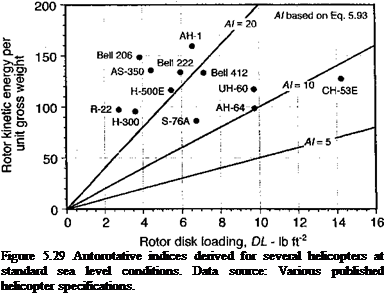Autorotation Index
It is clear that the autorotative performance of a helicopter depends on several interrelated factors. These include the rotor disk loading (which affects the descent rate), the stored kinetic energy in the rotor system (which influences the probability of success of entry and completion of the autorotational maneuver), as well as subjective “difficulty rating” flight assessments by pilots. To help select the rotor diameter during predesign studies, an “autorotative index” is often used. Although various types of indices have been used [see White et al. (1982) for a summary] the autorotation index is basically a stored energy factor. One form of the index can be defined in terms of the ratio of the kinetic energy of the main rotor to the gross weight of the aircraft, that is,
![]() R&2
R&2
m
which is used by Bell – see Wood (1976). An alternative autorotative index used by Sikorsky, which is weighted by disk loading [see Fradenburgh (1984)] is
These indices may be modified to reflect the effects of higher density altitudes by using, for example, with the latter index
 |
Figure 5.29 shows the autorotative index for several helicopters, which have been calculated using Eq. 5.93 based on published information for each helicopter. These indices are of great use in the sizing of the main rotor or in examining the effects on autorotative characteristics with increasing gross weight or density altitude. Note that the absolute values of the index are of no significance by themselves, but the relative values provide a means
of comparing the autorotative performance of a new helicopter design against another helicopter with already acceptable autorotative characteristics. An index of about 20 would normally be considered acceptable for single-engine helicopters. A multi-engine helicopter can have a lower index and still have safe flight characteristics in the event of a single engine failure because any initial decay in rotor rpm is soon picked up by increasing torque from the remaining engine(s).
The autorotative characteristics of the helicopter may also be expressed in terms of equivalent hover time – see Wood (1976). This is the time that the stored kinetic energy in the rotor system can supply sufficient equivalent power to hover before the rotor rpm decays to the point that stall occurs (see previous discussion on page 245). This “equivalent time” parameter seems to correlate well with pilot opinion of autorotative characteristics – see Prouty (1986) for a summary. Based on the results of Wood (1976), a helicopter with an equivalent hover time of 3 or more seconds is ideal but rarely possible, but a goal for a new helicopter will be to design for at least half of this value to assure sufficient margins in autorotational capability to be safe for an average pilot.













